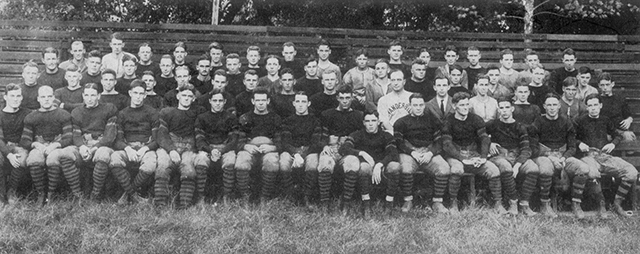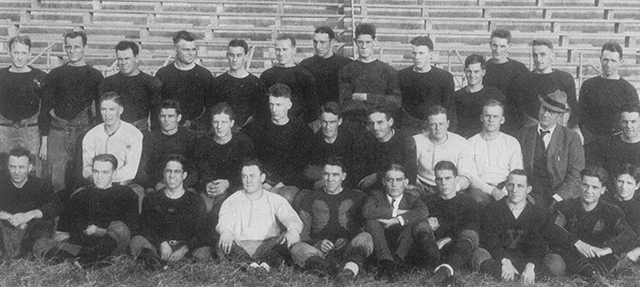Sept. 2, 2015

1921 Vanderbilt football team
Commodore History Corner Archive
Vanderbilt was a charter member of the Southern Intercollegiate Athletic Association (SIAA) from 1893 until March 1922, and then entered the Southern Intercollegiate Conference. That organization would eventually drop “Intercollegiate” and become the Southern Conference. In December 1932, the Southeastern Conference (SEC) was organized with Vanderbilt as a charter member. The SEC’s first official season began in the fall of 1933. The Commodores can claim several SAIA football championships, but none in the SEC.
But can Vanderbilt claim two football national championships in 1921 and 1922?
The 2015 NCAA Football Records list in its National Poll Rankings section that Vanderbilt was the national champion in 1921 and 1922 by college football historian Clyde Berryman.
It has been established for some time that college football historians and organizations retroactively, predate and also currently project a national champion by the use of records, stats, mathematics, formulas, etc. These findings revert back to 1869 when college football is said to have had its roots. Located on the Internet are multiple stories by sports writers referring to, and sometimes challenging these championships.
From the 2015 NCAA Football Records:
“Over the years, there have been more than 30 selectors of national champions using polls, historical research and mathematical rating systems. Beginning in 1936, the Associated Press began the best-known and most widely circulated poll of sportswriters and broadcasters. Before 1936, national champions were determined by historical research and retroactive ratings and polls.”
United Press began selecting a college football national champion in 1950 (coaches poll), but merged with International News Service in 1958 and became United Press International (UPI). In 1991, UPI was taken over by USA Today/CNN and in 1997 became USA Today/ESPN. The following season the Bowl Championship Series (BCS) arrived and lasted though the 2013 season to be replaced by the College Football Playoffs the next year.
However, the NCAA has never “officially” proclaimed a national champion in football. The independent pollsters have taken that responsibility. The NCAA lists these historical researchers’ results only as being the national champion of a “poll.”
The Vanderbilt national championships in 1921 and 1922 by Berryman are far from being consensus. Listed in the NCAA book for National Poll Champions in 1921 are:
California: Billingsley, MOV, Boand, Football Research, Sagarin, Sagarin (ELO-Chess)
Cornell: Helms, Houlgate, National Championship Foundation, Parke Davis
Iowa: Billingsley, Parke Davis
Lafayette: Boand, Parke Davis
Vanderbilt: Berryman
Washington & Jefferson: Boand
Vanderbilt’s 1921 squad was 7-0-1 and led by legendary coach Dan McGugin (1904-17, 1919-34). Victories were recorded over MTSU (34-0), Mercer (42-0), Kentucky (21-14), Texas (20-0), Tennessee (14-0), Alabama (14-0) and Sewanee (9-0). The lone blemish was a tie with Georgia (7-7) in the seventh game of the season.
The Commodores were in a battle at Texas, but the toughest game of that season was against powerful Georgia in Nashville. In Fred Russell’s book “Fifty Years of Vanderbilt Football” published in 1938 the game with the Bulldogs is summarized:
“Sing, ye immortal muse, of the gridiron classic which was staged on October 27, 1921. It was the crowning achievement of the season, an unbelievable 7-7 tie with Georgia. This battle was to Vanderbilt supporters what Yorktown was to the revolutionary soldiers. Everything was against the Commodores. Georgia had weight, speed, and enviable record, the greatest line in the South. Vanderbilt had only psychological pressure. Dudley Field was overflowing. It was the game of the South.
“A furious first quarter went scoreless. Then Georgia began to rip the Vanderbilt tackles relentlessly. They tore down the field for gain after gain. Hartley came in for Randall and immediately Reynolds shot an 18-yard pass which he gathered in on Vanderbilt’ 12. Three attempts at the line netted only three and a half yards. Then Hartley made five and Vanderbilt was penalized. Four more plays and Reynolds went over by inches. Pew kicked the extra point. The half was over. No one would have given a dime for the Commodores’ chances. Georgia had gained 113 yards the first half against Vanderbilt’s nine.
“Somehow McGugin’s men came back with amazing fury. They were aroused. They battled on even terms through the third period. Soon after the fourth quarter ended, Neely intercepted a pass and weaved back 25 yards to Georgia’s 40. Two passes failed. Tom Ryan dropped by to kick. The punt traveled 25 yards. It fell hopping among a cluster of Georgia and Vanderbilt players. ‘Let it go, let it go!’ yelled ‘Fats’ Bailey [Vanderbilt guard], rushing in front of big [Georgia lineman ‘Bum’] Day. [Vanderbilt halfback Rupert] Smith leaped for the ball and dashed 15 yards across the line. Calmly, he added the tying point and it ended that way, 7-7.”

1922 Vanderbilt football team
Listed in the NCAA book for National Poll Champions in 1922 are:
California: Billingsley, MOV, Houlgate, National Championship Foundation, Sagarin
Cornell: Helms, Parke Davis
Iowa: Billingsley
Princeton: Boand, Football Research, National Championship Foundation, Parke Davis, Sararin (ELO Chess)
Vanderbilt: Berryman
Vanderbilt’s 1922 team was 8-0-1 with wins over MTSU (38-0), Henderson-Brown (33-0), Texas (20-10), Mercer (25-0), Tennessee (14-6), Kentucky (9-0), Georgia (12-0) and Sewanee (26-0). The tie was with Michigan (0-0) in new Dudley Field’s dedication game. “Fifty Years of Vanderbilt Football” recounts that game with the powerful Wolverines led by Commodore halfback and captain Jess Neely:
“Capt. Neely, his injured left arm limp at his side, met Capt. Goebel in the center of the field. [Vanderbilt end] Lynn Bomar kicked off and a moment later ruined Cappon [Michigan end] with a devastating tackle. Gracefully, Kipke [Michigan halfback] then punted 55 yards over the goal line. Scotty Neil [Vanderbilt end] punted right back and Kipke was stunned by Neely’s tackle. He stayed in the game, kicked again, and this time Neil punted out short to Vanderbilt’s 26.
“Immediately the Wolverines drove to the three-yard line, first down. Neely’s voice urged his men to hold ’em. Cappon made a yard. Kipke lost one. Cappon drove to the 1-foot line. Again, Neely’s voice: ‘Stop’em!’ Rising as one, the Commodore forewall threw back the next thrust. No one knew it at the time, but Michigan was tied right there. Vanderbilt had one chance, when Neely tackled Kipke on a punt, he fumbled, and Neely himself recovered. Promptly Captain Jess passed 25 yards to McCullough, but the threat died there. A scoreless tie, and tears of joy trickled down Neely’s face as he carried the ball off the field.”
According to his website, Clyde Berryman uses a formula, “Quality Point Rating System” that is a “mathematical formula rating system for evaluating the performance of American football teams which takes into account a team’s schedule, strength, won-loss record, and its points fielded/points allowed.”
Berryman used his system from 1990-2011.
Vanderbilt can consider claiming the football national championships for 1921 and 1922 if they follow the lead of other universities that list a national title by historical research and formulas.
The University of Mississippi list in its 2015 Football Media Guide and official athletics website their national championships for 1959 (Berryman, Dunkel, Sagarin), 1960 (Billingsley, DeVold, Dunkel, Football Research, Football Writers, National Championship Foundation, Williamson) and 1962 (Billingsley, Litkenhous, Sagarin, Sagarin-ELO Chess).
However, the official national champions by both AP and UPI are Syracuse (1959), Minnesota (1960) and Southern Cal (1962) is not disputed. Ole Miss has benefited from historical research with three “shared” national championships. They do not have any undisputed national championships in football.
Auburn University lists its national championships in 2010, 1993, 1983, 1957 and 1913. The 2010 and 1957 titles are undisputed. The 1913 title is courtesy of Richard Billingsley’s mathematics formula. Auburn touts its 1993 national championship from the National Championship Foundation. Billingsley has been determining a national champion from 1970 to present.
That 1993 team under coach Terry Bowden was undefeated, but on NCAA probation and not eligible for the SEC Championship Game nor a bowl invitation. Florida State was that season’s consensus national champion.
The 1983 national title was given to the Tigers by Billingsley, Football Research, FACT, NY Times and Sagarin (ELO-Chess). Auburn was 11-1 that year under coach Pat Dye while Miami (Fla.) were the recognized national champs by AP, UPI and USA Today/CNN.
Auburn and Ole Miss are neither right nor wrong in recognizing these historically researched national championships. There is no correct answer. Various universities in the country proudly list these extra championships on their official athletic websites and media guides like Alabama, Southern Cal, California, Ohio State, Minnesota, Michigan, Tennessee, Pittsburgh, Georgia and Notre Dame.
Universities that are listed as historical national champions, but do not recognize them, are Nebraska, Penn State, Oklahoma and Texas.
This writer is a researcher and historian of Vanderbilt athletics and certainly recognizes the hard work, expertise, dedication and research of these respected and experienced college football historians. It is interesting, entertaining and possibly necessary to rate college football teams at least prior to 1936 with the devised formulas from the modern era. After all, haven’t college football polls been based on opinions and often brought controversy?
Now back to Vanderbilt. It would be up to the discretion of the university to decide and accept Berryman’s formula and recognition of Vanderbilt football national championships in 1921 and 1922.
“We have a lot of respect for history and the tremendous success and the tradition it spawned from Coach Dan McGugin’s 30-year tenure early in the 20th century,” said Rod Williamson, Vanderbilt’s Director of Athletic Communications. “We are proud of the achievements of the Commodore men that date back more than 90 years. The 1922 team was historic with the arrival of the new stadium, the epic tie with Michigan and future leaders, such as Jess Neely.
“All this said, it seems to us that to suddenly declare, as others would view it, that we have won two national championships when we had not recognized them before would be anticlimactic, after the fact. Personally, I’d like to take a middle-of-the-road approach where we let history write itself, but we come up short of modifying our record book.”
Traughber’s Tidbit: These are a portion of the historians and organizations that provided a research system to determine a college football national champion with their active seasons: Boand (1930-60), Sagarin (1978-present), Helms (1941-82), Houlgate (1927-58), Park Davis (1933), National Championship Foundation (1980-2000), Dickinson (1933-40), Devold (1945-2006), Wolf (1992-present) and Dunkel (1929-present). Casper Whitney (1905-07) was one of the founders of the first All-American football team and selected national polls for Outing Magazine.
Tidbit Two: Edward E. Litkenhaus was a Vanderbilt chemical engineering professor who along with his brother, Frank, developed a system to project a college football national champion from 1934-84.
If you have any comments or suggestions contact Bill Traughber via email WLTraughber@aol.com.


